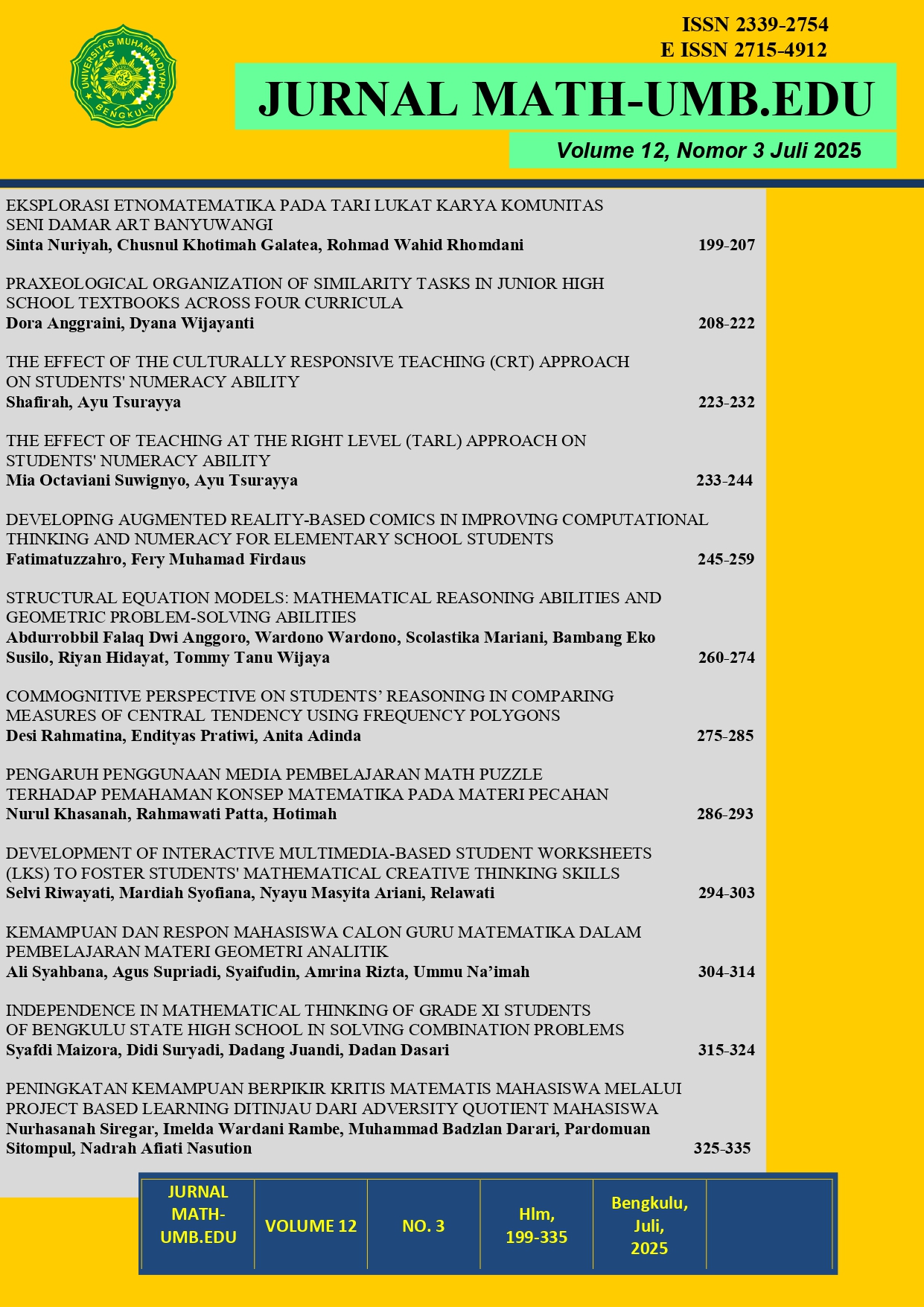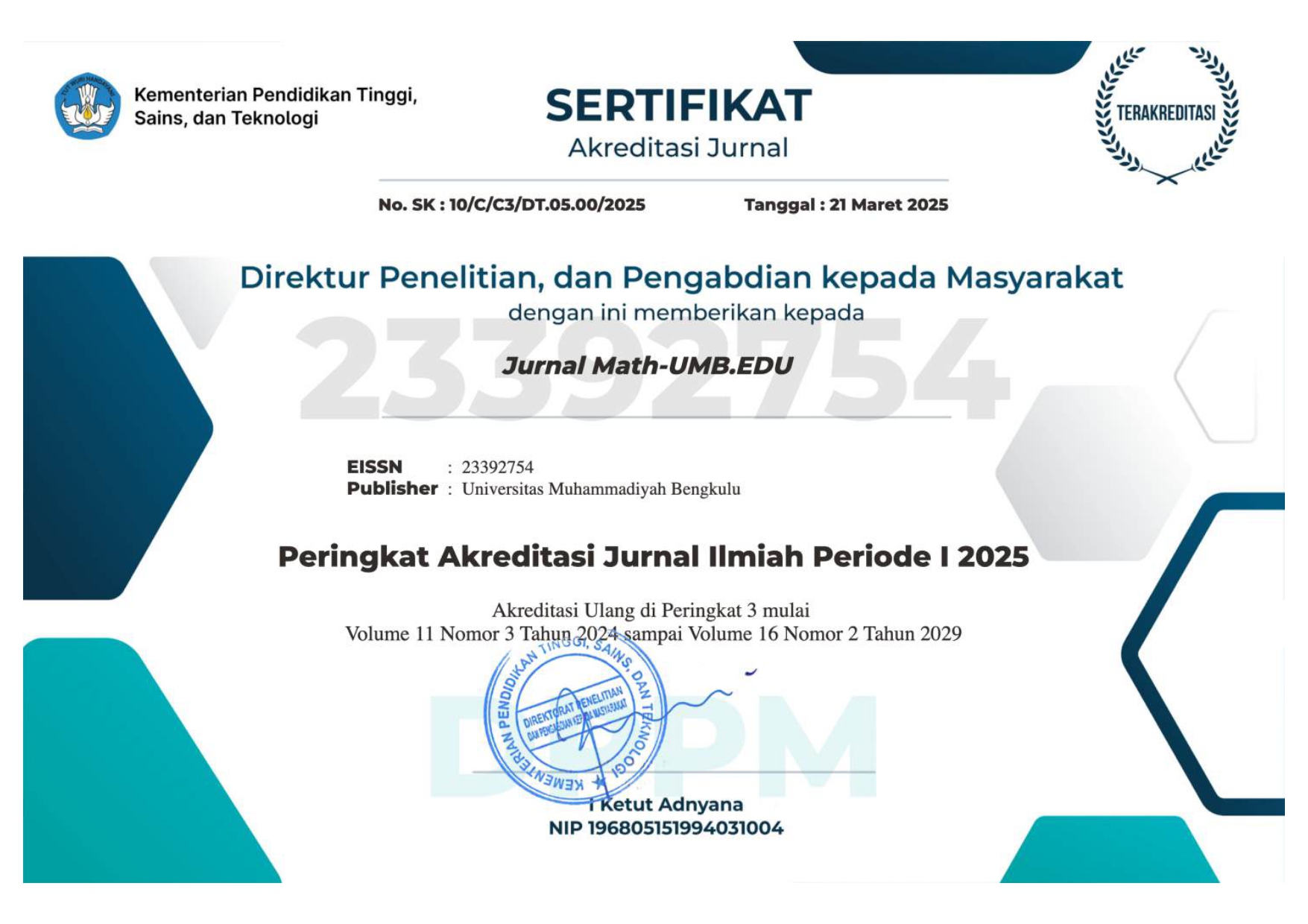STRUCTURAL EQUATION MODELS: MATHEMATICAL REASONING ABILITIES AND GEOMETRIC PROBLEM-SOLVING ABILITIES
DOI:
https://doi.org/10.36085/mathumbedu.v12i3.8659Abstract
This study aims to test the compatibility of structural equation (SEM) models to determine the relationship between mathematical reasoning ability and geometry problem solving ability. Using an ex-post facto research design, this study took a random sample of 100 students from a total of 296 mathematics education student population at a university in Lubuklinggau. Data were collected through mathematical reasoning tests and geometry problem-solving tests, then analyzed using the Lisrel 8.8 and SPSS programs. The results of the analysis show a very significant path coefficient, which proves that mathematical reasoning ability has a positive direct relationship with geometry problem-solving ability. This means that an increase in reasoning skills will be followed by an increase in the ability to solve geometry problems. In conclusion, this study confirms the existence of a direct relationship between the two variables, where mathematical reasoning ability contributes 15.13% to the improvement of geometry problem-solving ability.
Keywords: Ability, Mathematical reasoning, Geometric Problem Solving, SEM, Lisrel
References
Anggo, M. (2011). The involvement of metacognition in mathematical problem-solving. Edumatics, 01(April), 25–32.
Bayuningsih, A. S., Usodo, B., & Subanti, S. (2018). Critical thinking level in geometry based on self-regulated learning. Journal of Physics: Conference Series, 983(1). https://doi.org/10.1088/1742-6596/983/1/012143
Berlyand, L., & Jabin, P.-E. (2023). Mathematics of Deep Learning. Mathematics of Deep Learning. https://doi.org/10.1515/9783111025551
Bintoro, H. S., Waluya, S. B., Mariani, S., Candra, S. D., Pamungkas, M. D. Journal of Physics: Conference Series (Vol. 1918, Issue 4, pp. 124–142). IOP Publishing Ltd. https://doi.org/10.33423/jhetp.v22i16.5596
Cristia, J., & Cueto, S. (2020). Learning Mathematics in the 21 st Century EDITORS Elena Arias Ortiz.
Darto, Kartono, Widowati, & Mulyono. (2024). Student learning trajectories in finding the perimeter and area of a rectangular in the context of a fishing pond. Eurasia Journal of Mathematics, Science and Technology Education, 20(10). https://doi.org/10.29333/ejmste/15430
Dostál, J. (2015). Theory of Problem-solving. Social and Behavioral Sciences, 174, 2798–2805. https://doi.org/10.1016/j.sbspro.2015.01.970
Hasanah, S. I., Tafrilyanto, C. F., & Aini, Y. (2019). Mathematical Reasoning: The characteristics of students' mathematical abilities in problem-solving. Journal of Physics: Conference Series, 1188(1). https://doi.org/10.1088/1742-6596/1188/1/012057
Helviyana, G., Susanti, E., Indaryanti, Sari, N., & Simarmata, R. H. (2020). Students' mathematical reasoning in inquiry learning model. Journal of Physics: Conference Series, 1480(1). https://doi.org/10.1088/1742-6596/1480/1/012058
Hjelte, A., Schindler, M., & Nilsson, P. (2020). Kinds of mathematical reasoning addressed in empirical research in mathematics education: A systematic review. Education Sciences, 10(10), 1–15. https://doi.org/10.3390/educsci10100289
Inayah, N. (2016). The influence of mathematical reasoning skills and cognitive style on communication and connection skills in high school students' statistical materials. Journal of EST P-ISSN: 2460-1497 e-ISSN:2477-3840, 2(2), 74–80.
Ismunarti, D. H., Zainuri, M., Sugianto, D. N., & Saputra, S. W. (2020). Testing the reliability of the instrument against continuous variables for the measurement of chlorophyll-A concentrations of waters. Marine Oceanographic Bulletin, 9(1), 1–8. https://doi.org/10.14710/buloma.v9i1.23924
Jailani, J., Retnawati, H., Apino, E., & Santoso, A. (2020). High School Students' Difficulties in Making Mathematical Connections when Solving Problems. International Journal of Learning, Teaching and Educational Research, 19(8), 255–277.
Kadir, A., Rochmad, R., & Junaedi, I. (2020). Mathematical Connection Ability of Grade 8th Students' in terms of Self-Concept in Problem Based Learning. Journal of Primary Education, 9(3), 258–266. https://doi.org/10.15294/jpe.v9i3.37547
Lappan, G., Fey, J. T., Fitzgerald, W. M., Friel, S. N., Phillips, E. D., Glenview, I., & Needham, M. (2002). Getting to know Connected mathematics. Prentice Hall. http://enrollment.pps.k12.or.us/.docs/pg/400/rid/13114/f/GettingToKnowCMP1.pdf
Lestari, S. A. P. (2019). Mathematical reasoning ability in relations and function using the problem-solving approach. Journal of Physics: Conference Series, 1188(1). https://doi.org/10.1088/1742-6596/1188/1/012065
Masfingatin, T., Murtafiah, W., & Maharani, S. (2020). Exploration of Creative Mathematical Reasoning in Solving Geometric Problems. Journal of Mathematics Education, 14(2), 155–168. https://doi.org/10.22342/jpm.14.2.7654.155-168
McDaid, T. (2020). Numeracy & Mathematics Learning Teaching & Assessment Manual. Education Resources Executive.
Mhlolo, M. K. (2012). Mathematical connections of a higher cognitive level: A tool we may use to identify these in practice. African Journal of Research in Mathematics, Science and Technology Education, 16(2), 176–191. https://doi.org/10.1080/10288457.2012.10740738
Mhlongo, S., Ndlovu, M., & Chirinda, B. (2024). Mathematics Teachers'Experiences of Using Online Teaching Resources for Professional Learning in a Context of Disadvantage. International Journal of Learning, Teaching and Educational Research, 23(10), 27–44. https://doi.org/10.26803/ijlter.23.10.2
Moursund, D. (2007). Introduction to Problem-solving in the Information Age. Http://Uoregon.Edu/~moursund/Dave/Index.Htm.
Mueller, M., Yankelewitz, D., & Maher, C. (2014). Teachers Promoting Student Mathematical Reasoning. Investigations in Mathematics Learning, 7(2), 1–20. https://doi.org/10.1080/24727466.2014.11790339
Nguyen, T. T. K., Ngo, T. P. A., Pham, A. T., Nguyen, D. D., Cheng, P. H., & Nguyen, V. B. (2024). Let's play! Transforming STEM education with board games. Eurasia Journal of Mathematics, Science and Technology Education, 20(8). https://doi.org/10.29333/ejmste/14920
Pambudi, D. S., Budayasa, I. K., & Lukito, A. (2020). The Role of Mathematical Connections in Mathematical Problem-solving. Journal of Mathematics Education, 14(2), 129–144. https://doi.org/10.22342/jpm.14.2.10985.129-144
Polya, G. (1973). How to solve it. A New Aspect of Mathematical Method. Princeton: University Press.
Polya, G. (1981). Mathematical Discovery on Understading, Learning, and Teaching Problem-solving. John Wiley & Sons, Inc.
Ramirez, J. (2024). Investigating effective teaching practices in advanced placement calculus AB: A qualitative exploration of student recounts. Journal of Pedagogical Research, 8(2), 147–190. https://doi.org/10.33902/JPR.202424366
Rarasati, N., Dharmawan, G., Swarnata, A., Zulfa, A. H., & Lim, D. (2020). Comprehensive Reading and Mathematics Assessment Tool. The SMERU Technical Report. www.smeru.or.id.
Reyhani, E., Ghasemi, F., & Rahimi, Z. (2021). Investigation of spatial ability of male and female students in 10th and 11th grade according to factors including spatial visualization, mental rotation, and spatial orientation. 15(2), 379–394.
Rohman, H. M. H., & Retnowati, E. (2018). How to teach geometry theorems using worked examples: A cognitive load theory perspective. In S. A. W., S. S., & B. F.B. (Eds.), Journal of Physics: Conference Series (Vol. 1097, Issue 1). Institute of Physics Publishing. https://doi.org/10.1088/1742-6596/1097/1/012104
Sandy, W. R., Inganah, S., & Jamil, A. F. (2019). The Analysis of Students’ Mathematical Reasoning Ability in Completing Mathematicalproblems on Geometry. Mathematics Education Journals, 3(1), 72–79.
Setiawan, A., Wardono, Wijayanti, K., Mulyono, & Bishtawi, H. O. (2024). The Mathematical Literacy Process Based on The Students' Mathematical Resilience. Journal of Ecohumanism, 3(7), 2824–2841. https://doi.org/10.62754/joe.v3i7.4420
Sukirwan, Darhim, D., & Herman, T. (2018). Analysis of students' mathematical reasoning. Journal of Physics: Conference Series, 948(1). https://doi.org/10.1088/1742-6596/948/1/012036
Tisngati, U., & Genarsih, T. (2021). Reflective thinking process of students in completing mathematical problems based on mathematical reasoning ability. Journal of Physics: Conference Series, 1776(1). https://doi.org/10.1088/1742-6596/1776/1/012035
Urrutia, F., Buc, C., & Barriere, V. (2023). Deep Natural Language Feature Learning for Interpretable Prediction. In B. H., P. J., & B. K. (Eds.), EMNLP 2023 - 2023 Conference on Empirical Methods in Natural Language Processing, Proceedings (pp. 3736–3763). Association for Computational Linguistics (ACL). https://doi.org/10.18653/v1/2023.emnlp-main.229
Waluya, S. B. (2018). Growing geometric reasoning in solving problems of analytical geometry through the mathematical communication problems to state Islamic university students. Journal of Physics: Conference Series, 983(1). https://doi.org/10.1088/1742-6596/983/1/012159
Weigand, H. G., Trgalova, J., & Tabach, M. (2024). Mathematics teaching, learning, and assessment in the digital age. ZDM - Mathematics Education, 56(4), 525–541. https://doi.org/10.1007/s11858-024-01612-9
Widada, W., Herawaty, D., Nugroho, K. U. Z., & Anggoro, A. F. D. (2021). Augmented Reality assisted by GeoGebra 3-D for geometry learning. Journal of Physics: Conference Series, 1731(1), 0–9. https://doi.org/10.1088/1742-6596/1731/1/012034
Wijayanto, S. H. (2008). Structural equation modeling with LISREL 8.8. Graha Ilmu. https://doi.org/10.26555/humanitas.v15i1.5282
Wittmann, E. C. (2020). Connecting mathematics and mathematics education. In Springer. Springer. https://doi.org/10.1007/9783030615703
Zakir, M. (2015). Description of Logical Reasoning in Solving Mathematics Problems Based on Students' Thinking Style of Students at SMPN 2 Pinrang. Journal of Mathematical Power, 3(2), 152. https://doi.org/10.26858/jds.v3i2.3229















